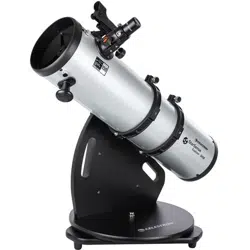Loading ...
Loading ...
Loading ...

12 I ENGLISH
DETERMINING MAGNIFICATION
AND SELECTING EYEPIECES
To change the telescope’s magnifi cation, you must
change the eyepiece in the telescope’s focuser. To
calculate the magnifi cation you can achieve with a given
eyepiece, use this formula:
Focal length of telescope ÷
Focal length of eyepiece
= Magnifi cation
For example, the SSE 130 Tabletop Dob has a focal
length of 650mm and a 25mm eyepiece. Using the
formula, we can calculate that this combination yields
a magnification of 26x (650mm ÷ 25mm = 26x). A
10mm eyepiece with the SSE 130 Tabletop Dob would
magnify 65x.
Use lower magnifications for locating and observing
wide-field deep space objects and higher magnifications
to view the Moon and planets. Do not increase
magnification too much; the view may degrade due to
atmospheric seeing conditions (i.e., air turbulence).
The maximum magnification for any telescope is about
60 times per inch, which equates to 269x for the SSE
114 Tabletop Dob, 307x for the SSE 130 Tabletop Dob,
and 354x for the SSE 150 Tabletop Dob. However, it
will be difficult to achieve sharp images much over 100x
magnification in many locations due to air turbulence. If
you notice that the stars overhead are twinkling heavily,
seeing conditions are poor. You should stick to lower
magnification. If the stars appear to shine steadily,
seeing conditions are good. You can try using higher-
magnification eyepieces.
The eyepiece rack on the base provides a convenient
place to put eyepieces when not in use (Figure 13).
Figure 13: The eyepiece rack is a convenient place to store additional
eyepieces during your observing session.
Select an object to view from the planetarium or the
“Tonight’s Best” list (tap the star icon). Arrows will appear
on-screen, guiding you to the object. Follow the arrows until
the bullseye turns green and the object is in your telescope’s
fi eld of view. It’s that easy!
While you observe, you can read detailed information about
the object. Hundreds of the most popular objects also offer
an audio presentation. To listen, press the bar at the bottom
of the screen that contains the object’s name (Figure 12).
Figure 12: Press the Object Info bar to receive additional information about
the selected object, including images and audio presentations for many
objects.
Loading ...
Loading ...
Loading ...
